Carpet vs Hardwood Flooring
Carpet
$7 - $12
(sq. ft. installed)
VS
Hardwood
$12 - $20
(sq. ft. installed)
Cost to install carpet or hardwood flooring varies greatly by region (and even by zip code).
To get free estimates from local contractors, please indicate yours.
Carpet
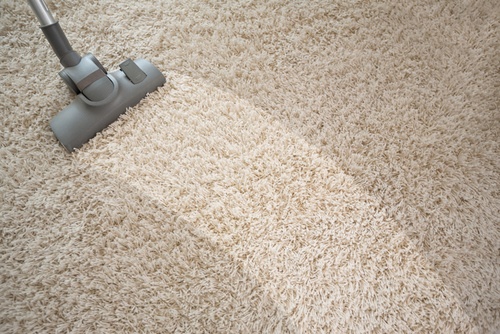
- Range of colors, fibers, and textures
- Insulating and warm
- Comfortable and soft
- Can be used with radiant heat
- May help absorb and muffle sound
- Easier installation
- Less likely to cause injury in a fall
- Less expensive
- Shorter lifespan
- More difficult to maintain
- Not as renewable
- May contain allergens and harbor mold
- Will require higher settings with radiant heat
- May fade in sunlight
(sq. ft. installed)
Get free advice and estimates from flooring contractors in your city.
Hardwood
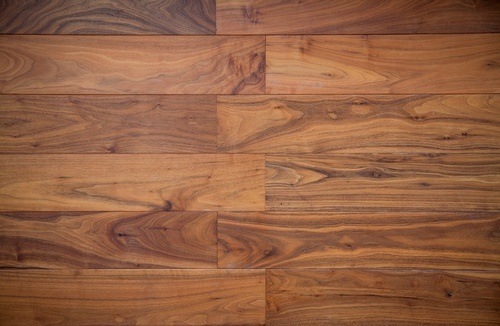
- Range of colors, styles, and species
- Easy to maintain and refinish
- Most can be used with radiant heat
- Does not harbor mold or allergens
- Extremely durable and long lasting
- Sustainable and renewable
- Harder and colder underfoot
- More difficult to install
- Offers no sound or heat insulation
- More likely to cause injury in a fall
- May darken in sunlight and humidity
- More expensive
(sq. ft. installed)
Get free advice and estimates from flooring contractors in your city.
Flooring may be the most important part of your house’s interior, and homeowners have numerous options available, both in terms of what materials they use as well as the style and appearance. Carpeting and hardwood are two of the most popular types of flooring being installed today. Both have benefits as well as drawbacks. We’ll outline the differences between them below, helping you to make a better decision about which is right for your home.
Appearance
Hardwood flooring has a classic appearance that can range in style from contemporary to rustic depending on the color, finish, and species of the wood used. Hardwood can be found in wide or thin planks, installed in straight rows or a herringbone pattern, and can range in color from pale to nearly black. Wood floors can also be stained a variety of colors, so you can refinish them in another color later if desired. Some hardwoods may change color over time if exposed to sun and humidity. For example, cherry will become darker in tone.
Carpeting has a broad range of colors and designs available, with newer carpeting types such as cut-and-loop, also known as pattern carpet, which gives a deeper variation in color and texture. Carpeting can be thick or thin, plush or hard, and may be composed of several colors at once or have one single color throughout. Because carpets are made of fibers rather than wood, they have a softer and warmer appearance. It’s common for hardwoods to be covered with Oriental or throw rugs to soften their appearance, but this is unnecessary with wall-to-wall carpeting. Many carpets also fade in direct sunlight over time.
Installation
Professional installation is recommended for both hardwood floors and carpeting. While carpet tiles and some types of engineered floating wood floors can be put in by experienced DIY homeowners, in most cases the installation requires experts.
Carpeting may be marginally easier to install than hardwood. As long as the subfloor 1 is sound, the carpet and pad 2 can be rolled and stretched into place and then cut and fastened around the edges. This gives a degree of flexibility to the project because only the edges of the carpet need to be cut and secured, which helps installation go faster.
Hardwood floors are often nailed or stapled into place, although some types of engineered hardwood may have a tongue and groove click-lock installation. Regardless, each board must be put down individually rather than in a large sheet like carpeting. This makes hardwood installation a longer and more complicated process with boards requiring careful cutting and fitting. In addition, if the hardwood has not been factory finished, it will need to be sanded 3 and have a finish coat applied after installation, which can add to the time and cost.
Costs
There is a range of prices for both carpeting and hardwood, depending on the type and quality of each. For example, a wool carpet will typically cost more than synthetic. A good quality wool may cost as much as $35 a square foot, while synthetic could cost as little as $1 to $2 a square foot. Carpeting costs must include the kind of pad, with thicker pads costing more than thinner. Typically, the cost of the carpeting and padding 2 is around $5 to $10 a square foot for the material, and installation costs around $5 a yard or roughly $2 a foot for a total of $7 to $12 a square foot installed.
Hardwood ranges in price depending on the type and quality of the wood. Exotic hardwoods 4 may run as high as $25 a square foot, while oak and maple, which are the two most common kinds of woods, run around $4 to $14 for pre-finished material. Including installation costs, most wood floors run between $12 to $20 a square foot installed.
Insulation and Comfort
Carpeting is a soft, warm material that insulates the floor below. Depending on the kind of pad used, as well as the type of material the carpet fibers are made of, you may find that the floor feels warmer with a carpet installed than with a hardwood floor. For this reason, many people choose to put rugs on top of hardwood, particularly in areas where children play to help make the area softer and more comfortable.
Moisture and Mold Growth
Both hardwood and carpeting can be affected by high moisture and humidity levels. For this reason, it’s recommended that solid hardwood floors be installed at grade level or above, and only engineered wood floors be installed below grade. Natural fiber carpets should also not be used below grade, but some synthetic fibers can be.
In addition to moisture issues, carpeting may harbor microbes, such as mold and mildew, as well as dust, dander, and other allergens. Hardwood is impervious to most of these issues, which may be the reason it is recommended for the homes of allergy sufferers.
Noise
With its soft fibers and insulating pad, carpeting helps to muffle noise in the rooms below, so people residing beneath a carpeted room are less likely to hear footsteps above them. Hardwood floors have no sound insulating properties and may amplify sound depending on the footwear worn.
Maintenance
Hardwood floors are arguably easier to clean than carpets. Hardwood can be swept or damp mopped to remove dust, surface stains, and other debris. Newer finishes applied to hardwoods help them resist staining and spills. If a stain does occur, most can be sanded 3 down and refinished to repair them.
Carpeting is harder to maintain because dust, dirt, and allergens can become trapped within the fibers. For this reason, the carpet should be vacuumed regularly to help free these particles. Stains, however, may be more difficult to remove and can require shampooing or special chemicals and treatments. Some carpets may be pretreated chemically to resist stains at the time of manufacturing. Synthetic fibers may resist staining better than natural carpet fibers.
Durability
Hardwood is a durable material that can last 50 to 100 years if properly installed and maintained. Solid hardwoods, in particular, can be resanded and stained many times to restore their finish.
Carpets only last as long as the quality of the material. Basic grade carpets only last about five years before they need to be replaced, while higher-quality carpets may last between 10 and 15 years.
Safety
Carpet is considered a safer flooring simply because it’s cushioned and is less likely to produce an injury if someone falls on it. However, old carpets that are stretched out of shape may cause a lump in the floor that could be a tripping hazard.
Environmental Impact
Some natural carpets, such as wool, have less of an impact on the environment than synthetic carpeting. Wool and other natural fibers are renewable and break down quickly without contaminating the environment. However, most synthetic carpets are made from petroleum, which is not renewable and can break down unevenly, giving off volatile organic compounds (VOCs) as it ages.
Hardwood is a renewable material, particularly if steps are taken to ensure responsible harvesting and planting of trees. Homeowners wishing to find a more sustainable material can check with the Forest Stewardship Council or look for the FSC label on the floor they are considering.
Radiant Flooring
Both carpets and hardwood floors can be installed with radiant heating. However, because the insulating properties of carpet, care must be taken to choose both a carpet and radiant heat system that work with one another. In some cases, the radiant heat system may need to be set higher for the carpet to warm sufficiently. In other cases, using a high-density but low-insulating carpet may produce the best effects.
Hardwoods work with many radiant heat systems because they transmit heat with little loss or insulation. However, there are some limitations such as the fact that it is not recommended to use radiant floor heating 5 under a plank wider than three inches. As the temperature changes and condensation builds up, the floor may be damaged quickly. To know more about the use of hardwood/bamboo flooring over radiant heating, consult the American Hardwood Information Center.
Remodeling Terms Cheat Sheet
Definitions in laymen's terms, cost considerations, pictures and things you need to know.See full cheat sheet.
 1 Subfloor: The bottom-most layer of a floor, supported by joists, over which finished flooring material is laid
1 Subfloor: The bottom-most layer of a floor, supported by joists, over which finished flooring material is laid
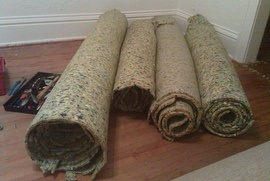 2 Pad: A cushion placed under a carpet to absorb impact, thus extending the life of the carpet
2 Pad: A cushion placed under a carpet to absorb impact, thus extending the life of the carpet
 3 Sanded: Process of removing the top surface of a material, such as wood, using sandpaper and/or a specialized sanding machine (for large surface areas)
3 Sanded: Process of removing the top surface of a material, such as wood, using sandpaper and/or a specialized sanding machine (for large surface areas)
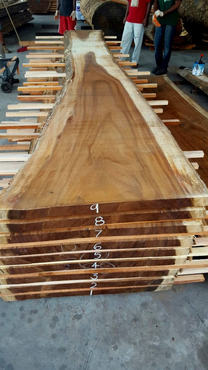 4 Exotic hardwoods: Timber from deciduous, flowering, seed-bearing trees that grow in tropical rainforests
4 Exotic hardwoods: Timber from deciduous, flowering, seed-bearing trees that grow in tropical rainforests
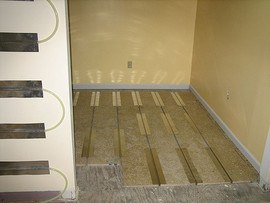 5 Radiant floor heating: (Also known as Radiant floor) A heating system using tubes or electric wires installed underneath the flooring
5 Radiant floor heating: (Also known as Radiant floor) A heating system using tubes or electric wires installed underneath the flooring
How much does it cost to install carpet or hardwood flooring in my city?
Cost to install carpet or hardwood flooring varies greatly by region (and even by zip code).
To get free estimates from local contractors, please indicate yours.